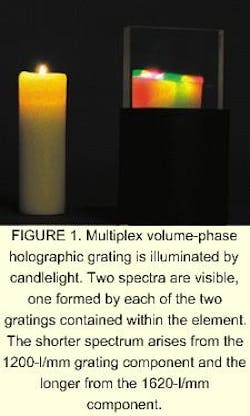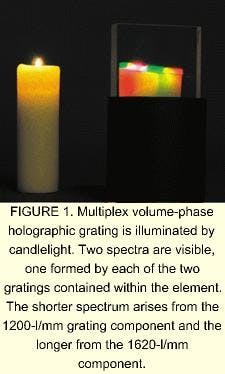GRATINGS - New holographic gratings look at the cosmos
Samuel Barden, Willis Colburn, and James Arns
A relatively new type of grating shows potential for improving the performance of the next generation of optical and near-infrared astronomical spectrographs. Called a volume-phase holographic (VPH) grating, the device diffracts light by modulations of the refractive index in a layer of dichromated gelatin. In many applications, such a grating can achieve higher diffraction efficiencies than classical surface-relief gratings that diffract light by the presence of modulated surface structure. The ability to make complex VPH grating structures-impossible with surface-relief gratings-allows the creation of new concepts for astronomical spectrographs.
To better understand the capabilities of these gratings, the National Optical Astronomy Observatories (NOAO; Tucson, AZ) is evaluating a set of eight VPH gratings in collaboration with the company that fabricates them-Kaiser Optical Systems Inc. (Ann Arbor, MI).1 This study, which is funded by the National Science Foundation (NSF; Washington, DC), has already led to new spectrograph concepts being considered for development by observatories around the world, including the Anglo-Australian Observatory (Sydney, Australia) and the European Southern Observatory (Garching, Germany).
How a VPH grating works
Volume-phase holographic gratings diffract light at angles corresponding to the well-known grating equation. The energy envelope, however, is governed by the Bragg condition similar to the diffraction of x-rays by crystalline structures. The intensity of the refractive-index modulation and the depth of the grating layer are critical parameters in the performance of the grating. Diffraction efficiency is a strong function of the wavelength of the incident light, the grating surface frequency, and the angle of incidence with respect to fringes formed as refractive-index modulations within the volume of the grating. If these relationships satisfy the Bragg condition, then high diffraction efficiencies approaching 100% are possible.
Although the diffraction efficiency decreases as either the angle or the wavelength deviate from the Bragg condition, the rate of decline depends on the depth of the grating medium. Wide angular bandwidths, wide wavelength bandwidths, or both are possible if the grating depth is kept to a minimum.
A VPH grating also can function at combinations of angles and wavelengths other than those for which it was designed. Tilting the grating with respect to the illuminating light source will give peak diffraction efficiency at the wavelength that meets the Bragg condition for the new angle. The diffraction efficiency of a particular wavelength may not be as high for a tilted grating as that for a grating optimally designed for the new angle and wavelength combination. However, it can still be sufficient to eliminate the need for a separate grating.
A VPH grating with 300 lines/mm (l/mm) produced for the NSF study shows excellent performance as the grating is tuned over a 600-1000-nm wavelength range. High efficiency was also measured for the second, third, and fourth orders of diffraction when appropriately tuned. Rigorous coupled wave analysis with the assumption of a saturated (flat-topped shape) refractive-index modulation predicts diffraction efficiencies similar to those measured for the 300-l/mm grating.
One replaces many
The diffraction efficiency (blaze envelope) of a surface-relief grating does not significantly change as a function of the grating tilt. This allows surface-relief gratings to accommodate various spectrograph design configurations without impacting their performance. However, separate gratings must be available if a change in spectral region beyond that covered by the blaze profile of the original grating is desired.
Likewise, if a different spectral dispersion is requested, then either a grating with a higher line density or a grating with a blaze profile shifted into a higher order of diffraction is required. The 300-l/mm VPH grating, on the other hand, gives considerable versatility in spectral coverage as well as dispersive power without the need to change gratings.
To accommodate the various tilt angles allowed with a VPH grating, a spectrograph must be capable of being reconfigured either to conform to the angles or to use prisms, mirrors, or both to direct the diffracted light to the camera. In certain applications, the added complexity of such a spectrograph may be desirable over the need for a large set of surface-relief diffraction gratings. A VPH grating-based spectrograph can also be automated for fast or remote reconfiguration for those situations in which multiple gratings would be difficult, if not impossible, to deploy.
Although reflection VPH gratings can be fabricated with quite high diffraction efficiencies, they tend to have very narrow bandwidths of only a few tens of nanometers. Astronomical applications typically require the observation of wide spectral regions and are therefore best served by transmission VPH gratings, which can have spectral bandwidths ranging from a few nanometers to a few hundred nanometers.
The transmissive nature of VPH gratings allows them to be designed to function in Littrow mode. This eliminates or minimizes anamorphic magnification, resulting in simplification of the camera optics. Astronomical spectrographs on large telescopes tend to require large beam diameters. The reduction of anamorphic magnification means the camera optics for a VPH grating spectrograph can be smaller (by a factor of up to 1.5) than they would be if the gratings used were classical reflective surface-relief gratings.
Another advantage of VPH gratings over classical gratings is the encapsulated nature of the VPH grating. The VPH grating is a laminated structure in which the grating is sandwiched between two glass plates. Surface-relief gratings are difficult, if not impossible, to clean due to the fragile nature of the grating structure. Over time, dirt and oxidation can deteriorate the performance of such a grating. But VPH gratings are sealed from dirt, and the glass surfaces can be cleaned without risk to the grating. It is also possible to apply high-performance antireflection coatings to the substrate surfaces of a VPH grating to further enhance its efficiency and reduce spurious signals.
Multiplex VPH grating
Kaiser Optical Systems has developed and patented a multiplex grating structure-the Holoplex grating-in which two separate VPH gratings are sandwiched into a single optical element. Such a device allows manipulation of the spectrum that is difficult to do with classical grating technology.
A multiplex grating was fabricated as part of the NSF study. This specific grating element contains both a 1200- and a 1620-l/mm grating (see Fig. 1). The 1200-l/mm grating is optimized for peak diffraction at the Ha wavelength of the hydrogen atom (656 nm); the 1620-l/mm component is optimized for the Hb line of hydrogen (486 nm). The gratings were each designed to provide minimal diffraction efficiency at the wavelength for peak efficiency of the alternate grating. Thus, the 1200-l/mm grating is, in effect, invisible to the light at 486 nm. Likewise, the 1620-l/mm grating passes 656-nm light undiffracted.
The grating equation shows that both wavelengths are diffracted to an angle of 23° by their respective gratings with a grating tilt of 23°. To separate the otherwise overlapping spectra, the fringe planes of the two gratings are slightly rotated with respect to each other.
The measured efficiency in unpolarized light of this VPH grating is 93% for the 1200-l/mm channel at 656 nm and 78% for the 1620-l/mm component at 486 nm (see Fig. 2). Rigorous coupled-wave analysis of the initial design parameters predicted a peak efficiency of about 90% for both grating components. The loss of efficiency in the 1620-l/mm grating is due to a redward shift of a first-order minimum in diffraction efficiency of the 1200-l/mm grating. About 12% of the light at 486 nm is diffracted by the 1200-l/mm grating at a diffraction angle of 11°. Other than this, the grating assembly is nearly perfect in terms of its performance.
Wide angular tunability
In addition to being used for simultaneous observation of the 486- and 656-nm lines of hydrogen, the grating can be tuned to observe the forbidden lines of oxygen at 373 and 501 nm by rotating the grating to an angle of 17°. Although the diffraction efficiencies are not optimal at this wavelength, they are still quite good, reaching levels of greater than 50%.
Also, the grating can be tuned to observe a galaxy with a Doppler redshift of 0.5, which has the Ha and the Hb lines shifted to 984 and 729 nm, respectively. Setting the grating at an angle of 36° modifies the grating efficiency so that these new wavelengths are diffracted with an efficiency of about 50%.
A tunable spectrograph utilizing this VPH Holoplex grating can simultaneously image the spectrum of these astronomically important features without the need for a large-format detector, a cross-dispersion grating or prism, or a dual beam-spectrograph configuration (see Fig. 3). Such a VPH spectrograph would be very versatile, compact, and more efficient than a comparable spectrograph using classical surface-relief gratings.
REFERENCE
- NOAO is operated by the Association of Universities for Research in Astronomy Inc. under cooperative agreement with the National Science Foundation.
SAMUEL BARDEN is a scientist at National Optical Astronomy Observatories, 950 N. Cherry Ave., Tucson, AZ 85719; e-mail: [email protected]. WILLIS COLBURN is vice president and chief scientist and JAMES ARNS is principal optical systems engineer at Kaiser Optical Systems Inc., POB 983, Ann Arbor, MI 48106; e-mail: [email protected] and [email protected].

